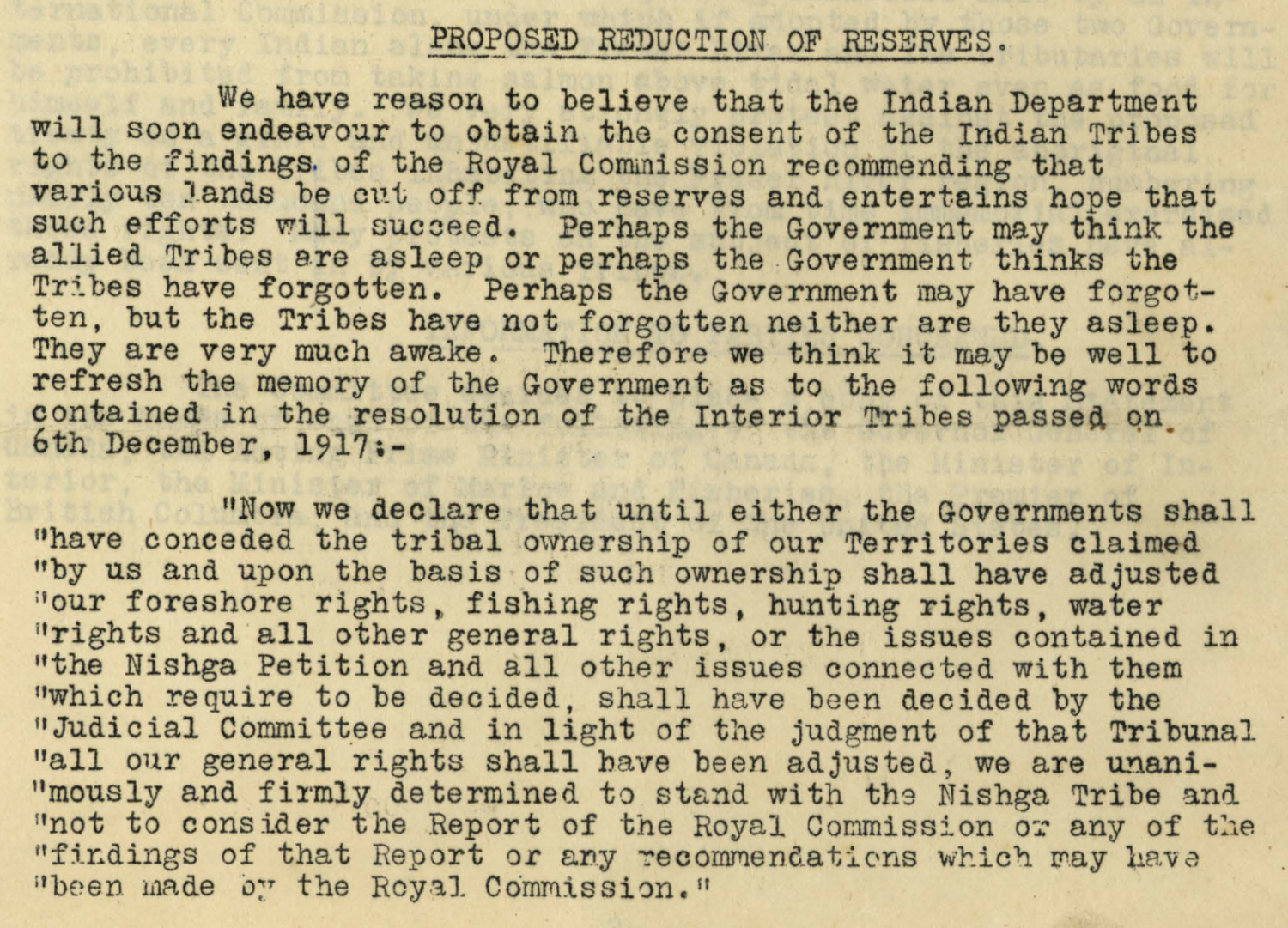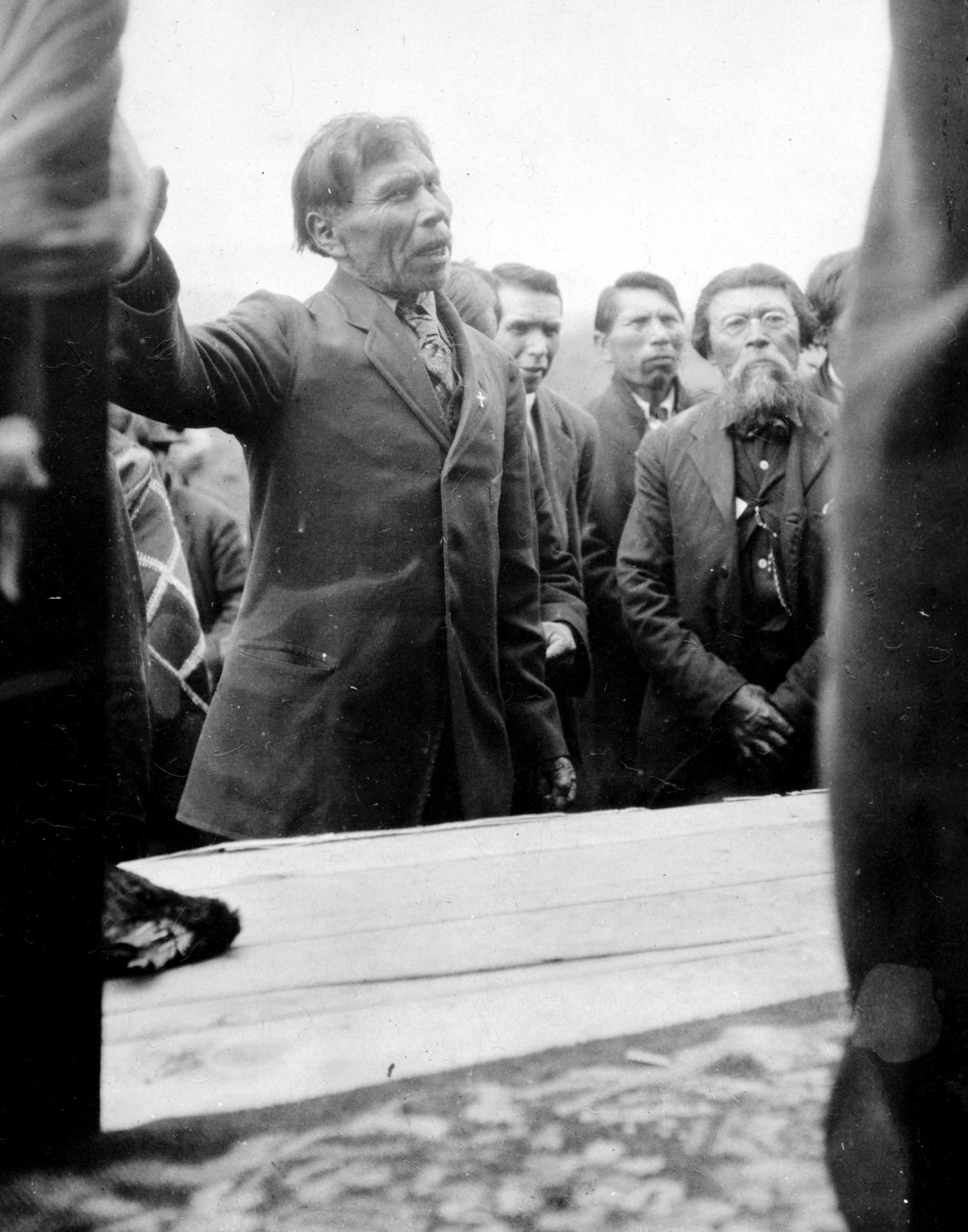The McKenna-McBride Commission
Indigenous continue to fight for land rights but lose more valuable territory
Date: 1913
In 1906, as waves of settlers spread out across British Columbia, a delegation of chiefs from the Squamish, Quw’utsun, Secwepemc, Okanagan, Nlaka’pamux and St’át’imc Nations journeyed to London to present King Edward VII with a petition decrying their inadequate reserves and B.C.’s lack of treaties. The following years saw more advocacy groups established, more petitions, declarations and letters written, and more trips to London and Ottawa — all an effort to safeguard the land and resources Indigenous people have relied on for millennia.
And initially the pressure campaign seemed to be working. In 1909, Prime Minister Wilfrid Laurier commissioned a lawyer named T.R.E. McInnes to evaluate Aboriginal title in B.C. His report recounted years of brazen deceit on the part of the provincial government. Not only did McInnes denounce the policy pursued by Joseph Trutch to shrink reserves to a fraction of their original size, but he said Aboriginal title likely still existed outside of B.C.'s reserves. The report said neither the provincial nor federal government could extinguish that title without Indigenous consent. A sympathetic Laurier tried to refer the issue to the Supreme Court, but B.C. Premier Richard McBride quashed that effort. “It would be madness to think of conceding to the Indians’ demands,” McBride said in 1909. “It is too late to discuss the equity of dispossessing the red man in America.”
The tide turned in 1911 after Laurier lost the election and Robert Borden became prime minister. In 1912, Premier McBride and J. A. J. McKenna, a government official Borden had appointed to resolve B.C.’s “Indian” issues, established a royal commission to review the province’s reserves. But the question of Aboriginal title wasn’t in their agenda. Instead, the commission focused exclusively on the location and size of reserves. From 1913 to 1916, commissioners met with Indigenous communities throughout British Columbia, though some nations refused to discuss their reserve lands. The Haida on what was then the Queen Charlotte Islands told commissioners they wouldn’t specify any area to set aside for reserves because all of Haida Gwaii belonged to them. Contrarily, despite being pressed wherever they went, commissioners refused to discuss Aboriginal title.
The commission completed its report in 1916. While the commission recommended adding roughly 87,000 acres to B.C.’s reserves, it also advised slashing about 47,000 acres from previous reserve territory. The new land was often poor, arid, rocky and away from traditional territory. Meanwhile, the so-called “cut-off” land that Indigenous communities lost was arable and greatly desired by incoming settlers. Though Indigenous peoples in B.C. were set to gain roughly 40,000 acres — a figure that was later reduced after years of wrangling between the provincial and federal governments — the land the McKenna-McBride Commission recommended taking away was equal to about $32 an acre; the land gained worth roughly $5 an acre. Still, as stated in the Indian Act, the commission said no land could be removed from reserves without the consent of the affected First Nation.
Indigenous leaders in B.C. quickly rejected the McKenna-McBride report. But it seemed to energize them. As the commission wrapped up its tour in 1916, several First Nations formed the Allied Tribes of British Columbia. “Perhaps the government may think the Allied Tribes are asleep or perhaps the government thinks the tribes have forgotten,” the organization wrote in 1919, soon after the McKenna-McBride report was released publicly. “Perhaps the government may have forgotten, but the tribes have not forgotten, neither are they asleep. They are very much awake.” However, their protests failed to move the needle. On July 1, 1920, the House of Commons passed Bill 13, which authorized the reduction of reserves without Indigenous consent — overriding both the commission and the Indian Act. An amended version of the commission’s recommendations was implemented in 1923. The Allied Tribes and other Indigenous groups continued to fight for their land rights until the federal government barred Indigenous people from fundraising to advance land claims in 1927.
Sources:
- Background to the McKenna McBride Royal Commission. 7 May 2021, https://web.archive.org/web/20080207082623/http://www.ubcic.bc.ca/Resources/ourhomesare/narratives/Background_2.htm.
- Feltes, Emma. "Research as Guest Hood: The Memorial to Sir Wilfried Laurier and Resolving Indigenous-Settler Relations in British Columbia." Anthropologica, vol. 57, no. 2, 2015, pp. 469–80.
- Foster, Hamar. "Honouring the Queen’s Flag: A Legal and Historical Perspective on the Nisga’a Treaty." BC Studies, vol. 120, 1998, pp. 11–36.
- Kopas, Leslie Clifford. Political Action of the Indians of British Columbia. University of British Columbia, Apr. 1972.
- McFarland, Dana. Indian Reserve Cut-Offs in British Columbia, 1912-1924 : An Examination of Federal-Provincial Negotiations and Consultation with Indians. University of British Columbia, Aug. 1990, https://open.library.ubc.ca/cIRcle/collections/ubctheses/831/items/1.0302324.
- McInnes, T. R. E. Report on the Indian Title in Canada, with Special Reference to British Columbia. Department of Indian Affairs, 1909, https://www.canadiana.ca/view/oocihm.9_10059/1?r=0&s=1.
- McKenna, J. A. J., et al. McKenna-McBride Agreement. 24 Sept. 1912, https://d3n8a8pro7vhmx.cloudfront.net/ubcic/pages/1439/attachments/original/1484858101/McKenna-McBride_Agreement.pdf?1484858101.
- Ministry of Aboriginal Relations and Reconciliation. B.C. Settles the Final Four of 22 Cut-off Claims. Backgrounder, Government of British Columbia, 4 Nov. 2008.
- Schuurman, Nadine Cato. Reinscribing Colonialism: The Royal Commission on Indian Affairs in Nlha’pamux and Stl’atl’imx Territory, 1914. University of British Columbia, July 1996, https://open.library.ubc.ca/cIRcle/collections/ubctheses/831/items/1.0087195.
- "The British Columbia Indian Lands Settlement Act." C. 51, S.C. 1920, 1 July 1920, https://laws-lois.justice.gc.ca/eng/acts/T-10.2/page-1.html.
- The Committee of the Indian Conference. Statement of the Committee of the Allied Tribes of British Columbia for the Government of Canada. 5 Feb. 1919, https://www.google.com/url?sa=t&rct=j&q=&esrc=s&source=web&cd=&ved=2ahUKEwj6jP_FyLXwAhUVrJ4KHaBsAesQFjAAegQIBxAD&url=http%3A%2F%2Fsummit.sfu.ca%2Fsystem%2Ffiles%2Firitems1%2F10353%2FIA_0021.pdf&usg=AOvVaw2UCD_bUXZlXRmoJKOzOwFx.
- Union of British Columbia Chiefs. Stolen Lands, Broken Promises. 2005, https://d3n8a8pro7vhmx.cloudfront.net/ubcic/pages/145/attachments/original/1508270002/CH1_Dispossession_and_Resistance_in_British_Columbia.pdf?1508270002.
- Wickwire, Wendy. At the Bridge: James Teit and an Anthropology of Belonging. UBC Press, 2019.





